The Changing Design Of Santa Claus
As it’s almost Christmas Day, I thought it might be a good time to take a look at how Santa’s look and feel has changed over time.
Today’s Santa Claus is believed to have been inspired by a 4th century Greek Christian bishop, Saint Nicholas of Myra. Saint Nicholas became known for his gifts to the poor. Early artists impressions portray him as a bearded man in canonical robes. A little something like this:

Image Credit: Wikipedia
The Norse pagan God, Odin has also been linked to Santa. According to folklore, Odin was recorded as leading a hunting party through the sky during the festival of Yule. Odin’s appearance was described in Icelandic stories as Síðgrani, Síðskeggr, Langbarðr, which all mean “long beard” and Jólnir which means “Yule figure”.
When children placed their boots filled with sugar, carrots or straw (for Odin’s flying horse) near the chimney, their kindness was rewarded by Odin with gifts. This idea continued in Germany and the European low countries when Saint Nicholas and Christianity were adopted, with the modern practice of hanging stockings on the chimney breast. Again there are many artists impressions of Odin, here’s one with him sporting a beard and red coat on his flying horse.
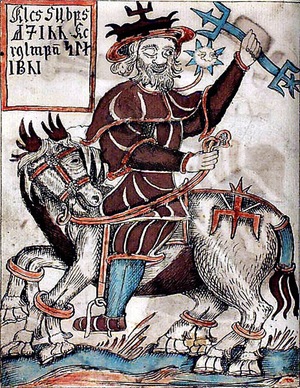
Image Credit: Wikipedia
In more recent times, Saint Nicholas and Sinterklass (the Dutch Saint Nicholas) merged with the British idea of Father Christmas to become Santa Claus. In the seventeenth century Father Christmas appeared wearing a long green fur-lined robe and delivered good cheer and spirit of Christmas.
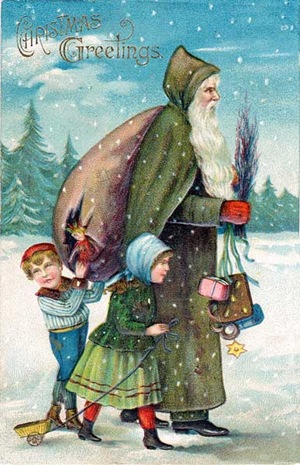
Image Credit: Postcard Images
Around this time in the Scandinavian countries, Saint Nicholas started to appear as a bringer of gifts with the Yule Goat. Over the next century, Nordic folklore described an elf called “Tomte” or “Nisse”, a short, bearded man dressed in gray clothes and a red hat. The tradition of the Yule Goat as a bringer of presents is pretty much dead in Scandanavia, but the straw goat is still a popular Christmas decoration.
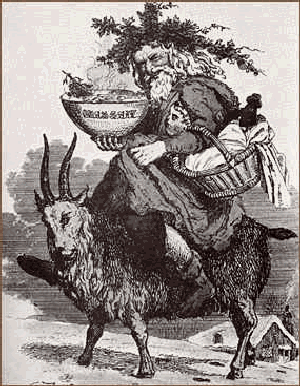
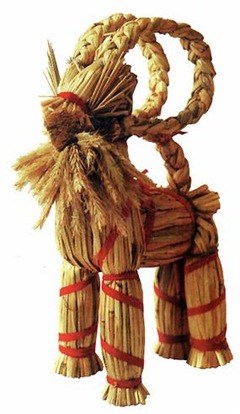
Image Credits: Left Wikipedia, Right Scandinavian-South
From the late 1700’s onwards Santa Claus started to appear in more stories in Britain and America. As writers described him in various ways (including a thick-bellied Dutch sailor with a pipe in a green winter coat), artists also began to depict Santa Claus and define the style we have become familiar with. Thomas Nast of Harper’s Bazaar is credited with being the first artist to define the modern Santa.
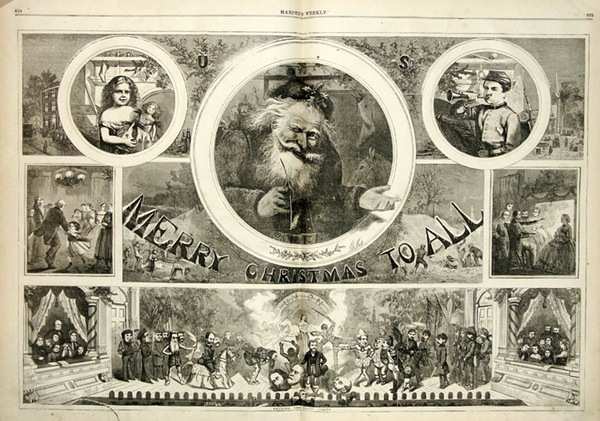
Image Credit: Son Of The South
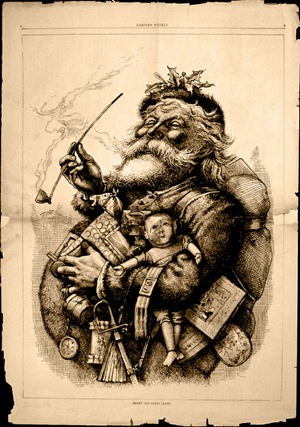
From this point on, Santa has been depicted as the round-bellied, jolly old man we know and love. The myth that Coca-Cola invented the modern Santa is untrue but they did use his image in much of their advertising. It’s also untrue that they invented his red and white costume based on their own branding. Below you can see a 1931 advertisement for Coke which appeared in the Saturday Evening Post. Over the years Coca-Cola hired artists to create a new, yet traditional Santa Claus which many of us now accept to be “the” Santa Claus.
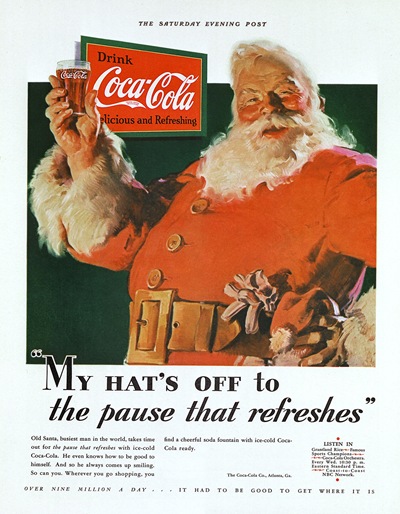
Image Credit: Coca-Cola
One of my friends brought her kids to see Santa at the weekend. And he was dressed in green and gave presents of small plants to the children. Is there a swing back towards the real old-school Santa of the eighteenth century with the long green fur-lined coat? Maybe there’s a teeny-tiny movement away from commercialism underway?
What do you think of the evolution of Santa’s appearance over the years?
Frequently Asked Questions about the Changing Design of Santa Claus
How has the design of Santa Claus evolved over the years?
The design of Santa Claus has undergone significant changes over the years. Initially, Santa was depicted as a stern, commanding disciplinarian clad in a variety of colors. However, in the 19th century, political cartoonist Thomas Nast began to popularize the image of Santa as a plump, jolly figure dressed in red. This image was further cemented by Coca-Cola’s advertising in the 1930s, which featured a rosy-cheeked Santa. Today, this image of Santa is recognized worldwide.
What influenced the modern design of Santa Claus?
The modern design of Santa Claus was largely influenced by commercial advertising. Coca-Cola’s advertising campaign in the 1930s, featuring a jolly, plump Santa Claus, played a significant role in shaping the current image of Santa. This image was based on the work of illustrator Haddon Sundblom.
Why did Santa Claus’ outfit change from green to red?
The change in Santa Claus’ outfit from green to red is largely attributed to the influence of Coca-Cola’s advertising. Before the company’s campaign, Santa was often depicted in a green suit. However, Coca-Cola dressed Santa in a red suit to match their brand colors, and this image became popular globally.
How did Thomas Nast contribute to the image of Santa Claus?
Thomas Nast, a political cartoonist, played a significant role in shaping the image of Santa Claus. He created a series of drawings for Harper’s Weekly starting in the 1860s, where he depicted Santa as a plump, jolly figure with a white beard and a sack of gifts. His version of Santa was a departure from the stern, bishop-like figure that was common before.
What are some unique interpretations of Santa Claus around the world?
Santa Claus is interpreted differently around the world. For instance, in the Netherlands, Santa, or Sinterklaas, is a bishop who arrives from Spain to distribute gifts. In Italy, a witch named La Befana delivers gifts, while in Russia, it’s Grandfather Frost. These interpretations reflect the cultural diversity and traditions of different countries.
How has the portrayal of Santa Claus in media influenced his design?
The portrayal of Santa Claus in media, particularly in movies and television shows, has greatly influenced his design. These portrayals often emphasize his jolly nature, generosity, and the iconic red suit, reinforcing the image of Santa that is popular today.
How has the design of Santa Claus impacted popular culture?
The design of Santa Claus has had a significant impact on popular culture. It has influenced holiday decorations, movies, music, and even fashion. The image of a jolly, gift-giving Santa Claus has become synonymous with the holiday season and the spirit of giving.
Are there any controversies related to the design of Santa Claus?
Yes, there have been controversies related to the design of Santa Claus. Some argue that the modern image of Santa, popularized by Coca-Cola’s advertising, has commercialized the holiday season. Others have called for more diverse representations of Santa that reflect different cultures and races.
How has the design of Santa Claus been used in games?
The design of Santa Claus has been widely used in games, particularly in holiday-themed ones. These games often feature Santa as a central character and incorporate elements of his design, such as his red suit, white beard, and sack of gifts.
How can I incorporate the design of Santa Claus into my own artwork or crafts?
Incorporating the design of Santa Claus into your artwork or crafts can be a fun way to celebrate the holiday season. You can draw inspiration from the traditional image of Santa, or put your own unique spin on it. Consider elements like his red suit, white beard, round glasses, and jolly demeanor. Remember, the most important thing is to have fun and let your creativity shine!
Jennifer Farley is a designer, illustrator and design instructor based in Ireland. She writes about design and illustration on her blog at Laughing Lion Design.
